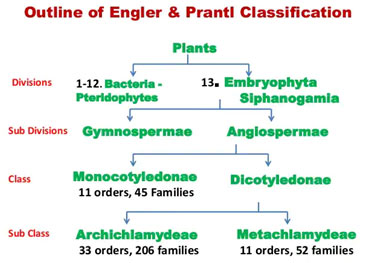Introduction
Two German botanists Adolph Engler and Karl Prantl published their classification system. They followed the classification system of Eichler which was a phylogenetic system. This system is also a phylogenetic system.
Phylogenetic System
The system of classification which uses morphological characteristics and phylogenetic relationships for the grouping of plants is called the phylogenetic classification system. This system is based on affinities and evolutionary relationships among plants.
Evolution joins the different groups of plants into a tree of phylogenetic groups. The system of Engler and Prantle replaced the natural classification system of Bentham and Hooker. This system dominates the plant taxonomy now.
Characteristics of the Classification system of Engler and Prantl
- The phylogenetic system classifies plants according to their affinities and phylogenetic relationships.
- This system follows a systematic plan and plants are arranged from simple to complex ones.
- This system states that most primitive flowering plants are without perianth.
- Monocotyledons are placed before dicotyledons.
- According to this system, evolution occurs from hypogyny to epigyny. The perigyny is intermediate between these two.
Classification system of Engler and Prantl
Division Embryophyta Siphonogama (Spermatophytes)
These are seed-producing plants and are divided into two subdivisions.
A. Subdivision Gymnospermae
These are naked seed plants. In these, the ovule is not enclosed in an ovary. This subdivision is further classified into the following major classes:
- Class Cycadales
- Class Bennettitales
- Class Ginkgoales
- Class Coniferales
- Class Cordaitales
- Class Gnetales
B. Subdivision Angiospermae
These are seed-producing plants and seeds are covered by fruits or enclosed in an ovary. This subdivision is further divided into two classes.
1. Class Monocotyledonae
These are the plants that have single cotyledons. They are without pith and cambium. The leaves of monocots show parallel venation. This class is further divided into the following major orders:
- Pandanales
- Heloboiae
- Tiruriuales
- Glumiflorae
- Principes
- Synanthae
- Microspermae
- Liliflorae
- Farinosae
2. Class Dicotyledonae
The plants which contain two cotyledons are called dicots and placed under this category. They develop pith and cambium. Their leaves show reticulate venation. This class is further divided into the following major orders:
- Piperales
- Salicales
- Myricales
- Batidales
- Urticales
- Proteales
- Blanophorales
- Polygonales
- Rosales
- Pandales
- Sapindales
- Malvales
- Opuntiales
- Ericales
- Primulales
- Ebenales
- Cucurbitales
Merits of the classification system of Engler and Prantl
- It has completely abolished the Monochlamydeae – a large artificial group of Bentham and Hooker classification systems whose families were distributed among related forms.
- Gymnosperms are classified and treated separately in this classification system.
- The families with inferior ovaries are treated in last. The advancement is from hypogyny to complete epigyny.
- Orchids were considered more highly evolved than the grasses.
Demerits of the Classification system of Engler and Prantl
- In this classification system, Amentiferae is regarded as the most primitive. These are reduced rather than a primitive group.
- According to Bassey and others, polypetaly was earlier. The apetaly was derived from it through modification.
- There is acceptance of derivation of dichlamydeous flowers (perianth in two series) from monochlamydeous in this system.
- Derivation of parietal placentation from axile placentation is also not true.

